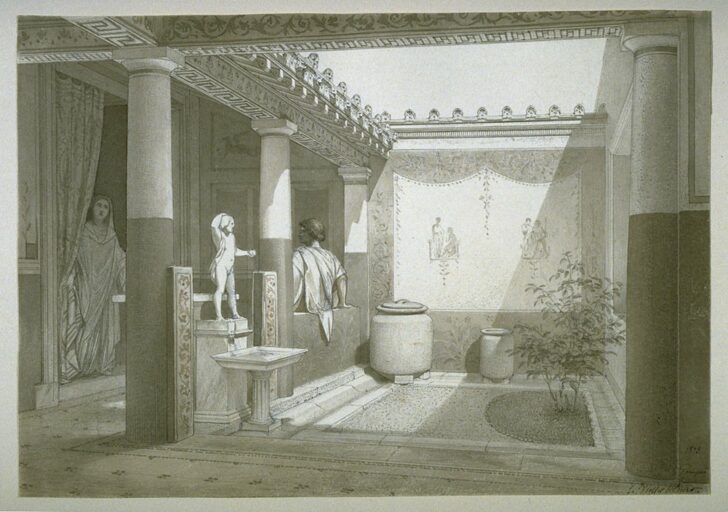Interior of a Pompeiian Home with Figures (The Impluvium)
Eugène Viollet-le-Duc

Description
Eugène Viollet-le-Duc
France, 1814–1879
Interior of a Pompeiian Home with Figures (The Impluvium)
1873
Ink and wash over graphite
Museum purchase, 1976/2.20
Viollet-le-Duc was a prolific writer and architect who became one of the moving forces in the newly established field of historical reconstruction of France’s cultural patrimony. Although his name is principally connected with nineteenth-century restorations of medieval cathedrals, abbeys, and fortifications such as at Carcassonne, Viollet-le-Duc was also interested in classical Italian architecture, as evidenced by his numerous trips to Italy. His visits to Naples involved interpolating details of the architecture and excavated artifacts of daily life to successfully evoke the past rather than obsessively describe it.
Such an approach, which informed his reconstruction of medieval monuments as well as works such as this drawing of a Pompeiian home, combine his extensive knowledge of architectural styles, romanticized view of the past, and deep interest in interior decoration. The impluvium was the inner courtyard of a Roman house where rainwater was collected.
(6/28/10)
Subject Matter:
The drawing is an artist's rendering of the interior of a house (domus) in the ancient city of Pompeii. Here, the artist is imagining what the inside of a Pompeiian house might have looked like during ancient Roman times. It shows the open-air courtyard which allowed sunlight and fresh air into the house. This scene shows an "impluvium" style courtyard where the rain water run off from the roof was collected in channels on the floor.
Physical Description:
An ink drawing in shades of gray with very exact detailing of objects and architectural elements in the scene. It shows the interior of a Roman house with sunlight streaming into an open courtyard with a fountain. The stone fountain has a square basin supported by a pedestal and a standing nude sculpture above it. One wall of the courtyard is decorated with floral designs and two figural scenes. A small bush is growing in a dirt area of the floor and there are two large vessels against the wall. Two figures are standing in a colonnade to the left of the courtyard. One is a woman dressed in a toga who is looking at a man dressed in a short sleeved tunic. The decorations of the floor, walls and ceiling depict ancient classical designs such as ascanthus leaves, meander and scroll patterns and the roof tiles have floral plume decorations and lion's head spouts.
Usage Rights:
If you are interested in using an image for a publication, please visit https://umma.umich.edu/request-image/ for more information and to fill out the online Image Rights and Reproductions Request Form.